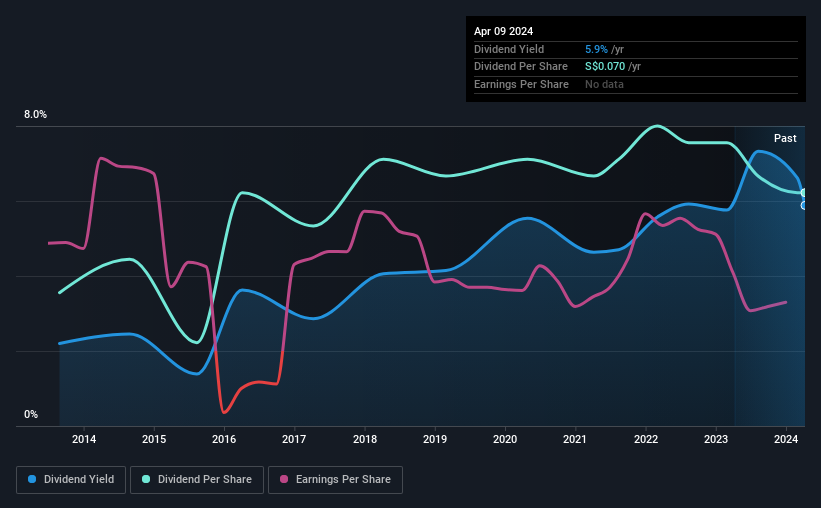Olam Group (SGX:VC2) Has Announced A Dividend Of SGD0.04
Olam Group Limited's (SGX:VC2) investors are due to receive a payment of SGD0.04 per share on 13th of May. The dividend yield of 5.9% is still a nice boost to shareholder returns, despite the cut.
See our latest analysis for Olam Group
Olam Group Doesn't Earn Enough To Cover Its Payments
We like to see robust dividend yields, but that doesn't matter if the payment isn't sustainable. Before this announcement, Olam Group was paying out 108% of what it was earning, and not generating any free cash flows either. Paying out such a large dividend compared to earnings while also not generating free cash flows is a major warning sign for the sustainability of the dividend as these levels are certainly a bit high.
Looking forward, EPS could fall by 6.8% if the company can't turn things around from the last few years. Assuming the dividend continues along recent trends, we believe the payout ratio could reach 125%, which could put the dividend under pressure if earnings don't start to improve.
Dividend Volatility
While the company has been paying a dividend for a long time, it has cut the dividend at least once in the last 10 years. Since 2014, the annual payment back then was SGD0.04, compared to the most recent full-year payment of SGD0.07. This implies that the company grew its distributions at a yearly rate of about 5.8% over that duration. It's good to see the dividend growing at a decent rate, but the dividend has been cut at least once in the past. Olam Group might have put its house in order since then, but we remain cautious.
Dividend Growth Is Doubtful
Given that the dividend has been cut in the past, we need to check if earnings are growing and if that might lead to stronger dividends in the future. It's not great to see that Olam Group's earnings per share has fallen at approximately 6.8% per year over the past five years. A modest decline in earnings isn't great, and it makes it quite unlikely that the dividend will grow in the future unless that trend can be reversed.
Olam Group's Dividend Doesn't Look Great
Overall, the dividend looks like it may have been a bit high, which explains why it has now been cut. The company's earnings aren't high enough to be making such big distributions, and it isn't backed up by strong growth or consistency either. Overall, this doesn't get us very excited from an income standpoint.
Companies possessing a stable dividend policy will likely enjoy greater investor interest than those suffering from a more inconsistent approach. Still, investors need to consider a host of other factors, apart from dividend payments, when analysing a company. For example, we've identified 4 warning signs for Olam Group (2 are a bit concerning!) that you should be aware of before investing. Looking for more high-yielding dividend ideas? Try our collection of strong dividend payers.
Have feedback on this article? Concerned about the content? Get in touch with us directly. Alternatively, email editorial-team (at) simplywallst.com.
This article by Simply Wall St is general in nature. We provide commentary based on historical data and analyst forecasts only using an unbiased methodology and our articles are not intended to be financial advice. It does not constitute a recommendation to buy or sell any stock, and does not take account of your objectives, or your financial situation. We aim to bring you long-term focused analysis driven by fundamental data. Note that our analysis may not factor in the latest price-sensitive company announcements or qualitative material. Simply Wall St has no position in any stocks mentioned.

 Yahoo Finance
Yahoo Finance 
